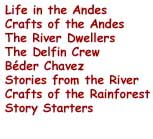

|
Wednesday, November 15, 2000 The Abundance and Distribution of River Dolphins in the Peruvian Amazon WOW! What a long name. Yet this is the name of Tamara's study. She has been studying dolphins in the same area of the Reserve for five years now. This is her last trip before she returns home to the United States. There she will examine her findings, write her dissertation, and publish her results. No doubt her heart is full feelings on this trip. Tamara's study is a continuation of a 1991 study that was conducted by Steven Leatherwood. At that time, not much was known about this area, and even less was known about the dolphins. For example, there were no accurate maps of the area and scientists didn't know that there are actually two species of dolphins here. Now, because of Steven's and Tamara's work, we know that the boto and the tuxcui species co-habitat in the Peruvian Amazon and its tributaries. We also know that the smaller, tuxcui is a more recent arrival to the area, while the larger, slower moving boto probably arrived here much earlier. The botos are actually more closely related to the Asian dolphins in China than to the tuxuci. The tuxuci are cousins of the marine dolphins that live along the coastal waters of the Atlantic Ocean. Be sure to read the background information about the two species on the site.
Can you identify which of the dolphins above are botos and which ones are tuxuci? What might account for the similarities between the boto and the species in China yet also explain why they live in such distant areas of the world? By returning to the same areas month after month, year after year and by using the same data collection methods, Tamara can begin to piece together a clearer picture of the dolphins over time. For example, she can compare the numbers and species type we counted August of 1999 in San Pablo Lake with the dolphin numbers and species type in the lake this August. Additionally, she can compare the dolphin count in the main channel to the dolphin count in a tributary when the water is high or low. By repeatedly collecting data at the same places and at the same times each year, she hopes to answer questions such as: How many dolphins are there in the Reserve? What is normal dolphin behavior? Where do the dolphins prefer to be? What is the impact of the interaction between dolphins and humans? And how do seasonal changes affect the dolphins? The larger question however is, "Is the Pacaya-Samiria Reserve really a reserve?" Meaning, are the habitats in good enough condition to support the dolphins that are here now and sustain the population over time. What do you think should be characteristics of a wildlife sanctuary or reserve? Study Area Because the Pacaya-Samiria Reserve is so large, Tamara could not possible study the dolphins in the entire Reserve. Instead, she must choose a smaller area and focus on three main habitats within this smaller area: main river channels or main stem rivers, tributaries and ox bow lakes. The Río Marañón and Río Amazonas are considered main stem rivers and primarily white water. White water is water that originates from the Andes Mountains and is rich in sediment and nutrients. It is the color of coffee with a lot of cream. Black water is found in the tributaries such as the Río Samiria and Río Yanayacu. The water looks like tea—clear, but stained dark from the tannic acid in the jungle plants. It is generally lacking in nutrients. (We prefer black water for bathing and swimming.) Tamara classifies existing ox bow lakes like San Pablo de Tipishca, where we are today, and Atun Cucha as deep, medium or shallow. Ox bow lakes were once part of a main stem river, but as the river changed course they were cut off from the main channel and became lakes. The difference between these and lakes we know is that ox bow lakes are connected to the main rivers through a channel. Can you find these lakes on the map? By choosing these areas to study Tamara hopes that they will be representative of the Reserve as a whole. This is often what researchers must do. They sample a smaller population and then extrapolate their findings to the larger population. While Tamara regrets that she hasn't been to the more remote areas in the Reserve, the trade off for her is that she will get a more complete "picture" of what is happening in a smaller, representative area over time. One of the main reasons we will be traveling so far into the Reserve this time is to determine if the habitats she has chosen for her study are indeed similar to those deeper in the Reserve, and whether her data is representative of the Reserve as a whole. How does Tamara measure habitat?
Yesterday as we traveled up the Río Marañón, we conducted our first transect. We were counting dolphins and recording the species for five long, hot hours. If you haven't already done so you will want to read about how we do a transect. Last year we did both transect and residency scans. Since Tamara has clocked over a thousand hours of residency scans we won't be doing any of those this trip. (Thank goodness, as they are really boring!) San Pablo Lake This morning, Tamara, Tracy, Enzo, Geoff, and Captain Antonio took the small skiff "Mango" into San Pablo Lake to collect data. The water level is less than half a meter—too low to take the Mirón Lento through the channel. At the mouth of the lake there were many botos and tuxcui. There were even very young ones.
At noon, the sky darkened, the wind started howling, and the rain poured. We scrambled to get everything downstairs and the tarps down over the sides of the boat. Lightening struck all around us and Captain Antonio worried that the wind might possibly capsize the boat. It was the strongest wind the captain had experience on this boat. For safety he had us all stand on one side to counter balance the wind. Yet, despite the ferocity of the rain, and the pitching of the boat, Horatio still managed to get lunch served promptly at 1:00. He is awesome! After lunch we continued traveling up the Marañón, performing a midline transect to its confluence with the Río Samiria. We hoped to get to Ranger Station 1 this evening which is located just up the Río Samiria but the rainstorm this afternoon kept us anchored close to shore for too long. Tomorrow we will begin very early. Once on the Río Samiria, we will be surrounded by Reserve. Last Minute Notes We have added one more step to the toilet flushing technique—BEFORE throwing water into the bowl, you must lift the toilet seat so that it isn't all wet for the next person. Add one more addition to the jungle symphony we hear at night—snoring. Lastly, for anyone thinking of purchasing mosquito-netting socks—forget about it! Just ask Geoff! Or, better yet, count the bites on his ankles. . |




